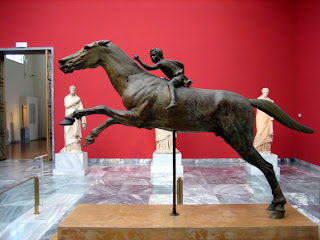GREEK ART – HELLENISTIC AGE
Ancient Greece was a civilization that existed in
between around 12th-9th centuries BC and around 600 CE. The
civilization can be divided into several periods; Greek Dark Ages, Archaic
Greece, Classical Greece and Hellenistic Greece. The Hellenistic Age begins in
323 BCE with the death of Alexander the Great and ends with the battle of Actio
in 31 BC. The Hellenistic Age marks the transformation of Greek society from
the localized and introverted city-states to an open, cosmopolitan, and at
times exuberant culture that permeated the entire eastern Mediterranean, and
Southwest Asia.
During the Hellenistic period, art underwent dramatic
transformations and evolved on the road paved previously by the Classical
artist. While the Classical Greek concepts were not entirely abandoned, the
artists of the Hellenistic era expanded their formal horizons with dramatic
posing, sweeping lines, and high contrast of light, shadow and emotions. The
conventions and rules of the Classical period gave way to the experimentation
and a sense of freedom that allowed the artists to explore their subjects from
different unique points of view.
Jockey of Artemision
150 - 140 BCE
The Jockey of Artemision is a large Hellenistic bronze
statue of a young boy riding a horse, dated to around 150–140 BCE. It is a rare
surviving original bronze statue from Ancient Greece and a rare example in
Greek sculpture of a racehorse. Most ancient bronzes were melted down for their
raw materials sometime after creation, but this one was saved from destruction
when it was lost in a shipwreck in antiquity, before being discovered in the
twentieth century. The horse gallops with tremendous speed; its movement and
anatomy are rendered with extreme realism. It is mounted by a very young boy,
whose tiny contorted figure and constricted face contrast with the animal's
majestic presence. The boy wears sandals and a short chiton, which is blown
back by the wind. He held reigns in his left hand and a whip in his right. The
sculpture, whose creator remains unknown, may have been dedicated to the gods
by a wealthy person to honor victories in horse races, probably in the
single-horse race.



Comments
Post a Comment